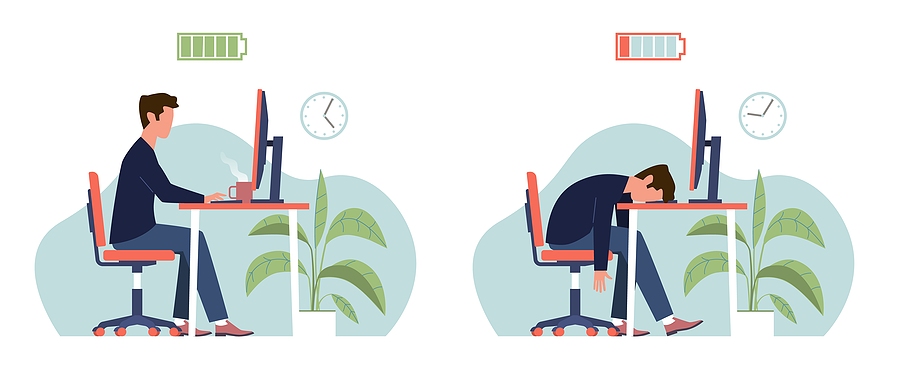
We get it- working from home may be starting to wear you down. Since the pandemic began, the average workday has been drastically different; chats by the water cooler have turned into pings on Google Hangouts, and team events have turned into Zoom parties from home. Now, we interact on a virtual plane, only ever speaking to each other on chats, video calls, and over the phone. The excitement you once had for remote work has been replaced by the stress brought on by the lack of separation between your professional and personal lives, and this feeling seems to be pretty widespread; 69% of workers have reported that they have experienced an increase in work-related stress since beginning their work from home journey, and this can cause high levels of burnout.
Furthermore, remote offices have led to a 2.5-hour increase in work hours since the start of the pandemic. The elongated workday is not only boosting employee’s stress levels but also having extremely negative effects on their mental health, causing high levels of fatigue on account of the thin line between work and home. It has even been shown that fully remote workers experience higher levels of burnout than those working in the office. When you live where you work (and work where you live), how can we avoid occupational burnout? First, let’s take a look at the common symptoms.
Signs of Burnout
When it comes to determining if you are truly burnt out, it is important to remember that symptoms of burnout can vary from person to person. Regardless of how this may manifest in you or your team members individually, getting in front of these negative feelings before they begin affecting work performance is imperative.
One important fact to note is that stress and burnout are not the same things. Yes, burnout can come as a result of stress, but it is a totally different state of mind. With stress, you are struggling to cope with pressures but are still attempting to move forward; with burnout, you feel a sense of hopelessness and your motivation simply dries up. According to Psychology Today, the most common signs of burnout at work are:
- Disillusionment/loss of meaning
- Mental and physical fatigue and exhaustion
- Moodiness, impatience, and being short-tempered
- Loss of motivation and a reduced interest in commitments
- Inability to meet obligations
- Lowered immunity to illness
- Emotional detachment from previous involvements
- Feeling efforts are unappreciated
- Withdrawal from coworkers and social situations
- Hopelessness, and a helpless and depressed outlook
- Job absenteeism and inefficiency
- Sleep deprivation
- Foggy thinking and trouble concentrating
So how can we prevent these symptoms and get ourselves back on the right track?
Set boundaries with your team and create a routine
We know it can be hard to close the laptop at the end of the day and put your chats on “do not disturb” after/before work hours. And it’s even harder to do so remotely as your team may feel that because you are home, you are always available for consultation. Establishing limits can be essential in getting your workday (and your mental health) back on track while also making yourself more productive during actual work hours.
One easy way to begin implementing boundaries into your routine is by setting a definitive beginning and end time for your day, making sure to schedule time for breaks and meals throughout your shift. Remember: if you’re burnt out, you cannot work effectively. Making yourself too available can be more detrimental to your productivity than you think.
Practice proper self-care
Though it may seem like spending most of your time at home opens the door to more self-care opportunities, it can be hard to take care of yourself if you’re feeling overwhelmed, helpless, and fatigued. But incorporating things back into your daily schedule that you genuinely enjoy can have a huge impact on your mood and productivity. By scheduling exercise before or after work (heck, maybe even throughout the day), you can reclaim some time for yourself and release some tension. It doesn’t have to be a hard day at the gym, either; a walk or light yoga can do wonders for the body and mind.
Getting quality sleep is another important piece of this self-care puzzle, so sticking to the schedule that we discussed above and creating a healthy work-life balance that allows for rest and relaxation is imperative in mitigating burnout. As the Irish Times has said, “It’s simple math. Sleep is key to burnout prevention with studies showing that insufficient sleep is one of the main risk factors in developing burnout and that sleep deprivation leads to 15 times higher risk of developing it.”
Take a break!
Whether the break is simply 15 minutes away from your desk or a full day off of work entirely, sometimes our brains just need a second to relax and recharge. Since working longer hours has left many remote workers more exhausted than ever, taking time for yourself needs to be a priority. With almost all our day being spent in front of a screen, it’s no surprise that many teams are experiencing high levels of fatigue as Zoom interactions have increased feelings of anxiety and stress.
So what is the importance of breaks at work? Well, to start, a 30-second break can boost your productivity by 13%. Furthermore, taking a 15-second break from looking at your screen every ten minutes can reduce that Zoom fatigue by 50%. Can you imagine what a full 8-hour break would do for someone who is experiencing high levels of burnout?
How can I help my team avoid burnout?
If your team seems to be struggling in the remote workspace, create an environment and culture that encourages create boundaries, taking breaks, and doing self care. By showing your employees that you truly care about their mental health and wellbeing, they will begin to feel more comfortable disclosing when they need break; this, in turn, will improve their relationship with the company while also increasing their productivity in the long run!
Check out how you can reconnect with remote employees here, and learn more about the perks they really want here.

